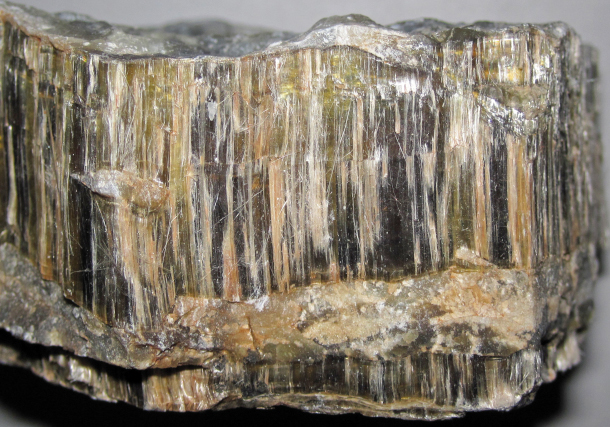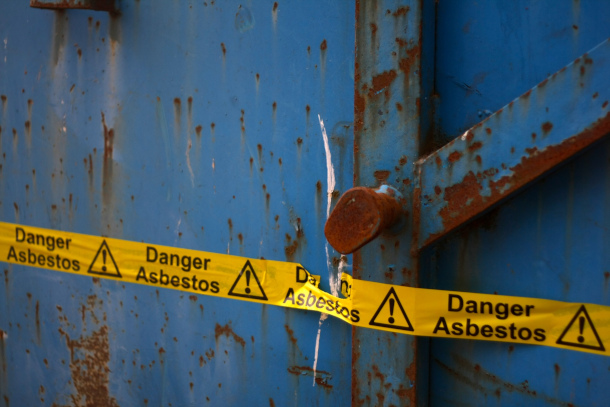EPA Finally Bans Asbestos
Air Date: Week of May 3, 2024

In March 2024, the EPA announced a ban on chrysotile asbestos, the only type of asbestos whose industrial use was still permitted in the U.S. Chrysotile asbestos is used in brake pads, sheet gaskets, and other products. (Photo: James St. John, Flickr, CC BY 2.0)
Asbestos is highly toxic to humans and after years of court and congressional battles the EPA is finally banning all uses of asbestos in the U.S. Maria Doa of the Environmental Defense Fund joined Living on Earth’s Jenni Doering to discuss why it took so long and the anticipated public health benefits of the phaseout
Transcript
CURWOOD: It’s Living on Earth, I’m Steve Curwood.
You may have seen the ads on TV. Law firms promising to win millions of dollars for sufferers of mesothelioma, an aggressive and deadly form of cancer linked to asbestos. But only just recently the EPA put in place a broad ban on the industrial use of asbestos, after years of court and congressional battles, interspersed with bureaucratic inertia. Maria Doa. the chemical policy director for the Environmental Defense Fund, put it all in perspective for Living on Earth’s Jenni Doering.
DOERING: What is it about asbestos that's so dangerous?
DOA: It gets deep into your lungs. And it can also get into other parts of the body. But the inhalation toxicity is the issue. And it embeds, and it irritates, and the body's trying to defend itself about it. And the other thing about it, which makes it good for use, is that it doesn't really break down. So it's not like your body can try to break it down and get rid of it very effectively.
DOERING: Now, given the health dangers posed by asbestos, it probably comes as a surprise to some that asbestos had not already been banned in the U.S. How important is this announcement?
DOA: It's extremely important that EPA is finally banning chrysotile asbestos, which, as you noted, is still used in industry, and also in some consumer products, including aftermarket brakes. So there's a potential for exposure from all these uses. So it's really important that the door is finally going to be closed on this very deadly chemical.
DOERING: How did we get to this point? What happened?
DOA: Well, EPA actually did try to ban asbestos in 1989. But there was a court case, and EPA lost most of the case, and so many of the uses of asbestos were still allowed to continue. One bright spot of that case, though, is that any new use of asbestos was precluded from starting up, and there were some uses of asbestos that did survive the court case and were banned.

Asbestos exposure has been linked to mesothelioma, lung cancer, and other health issues. (Photo: National Heart Lung and Blood Institute, Wikimedia Commons, public domain)
DOERING: So a federal judge blocked the EPA from banning asbestos when it tried to do that 30 years ago. What was the argument against the ban at that time?
DOA: Part of this is due to the fact that the primary law that governs toxic chemicals in this country, known as the Toxic Substances Control Act, at the time had a requirement that EPA do a cost-benefit analysis, and also that it choose the least burdensome option for managing the risk. And the least burdensome option for some of these cases was in the eye of the court, unfortunately, and so they could continue. In 2016, Congress amended the Toxic Substances Control Act and took away the requirement to do a cost-benefit analysis before it banned anything and to look for the least burdensome option. And had EPA make the determination based on risk, which is really important for a toxic chemical like asbestos. So EPA was able to go forward with asbestos and a number of chemicals, very toxic chemicals, and take action on addressing the significant risks associated with these chemicals. And asbestos is the first one that was finalized this action.
DOERING: So Maria, TSCA was amended during the Obama years. Why did it take eight years for this ban on asbestos, the first ban under that amended law, to be announced?
DOA: Well, work started on it immediately after it was passed. And subsequent to the Obama administration, when the Trump administration came in, banning these chemicals or limiting these chemicals were less important. And they were actually sued over the approach that they were taking that was so narrow, so it's taken a little bit of time to get back on track and move forward on trying to manage the risks from these chemicals.
DOERING: So now that asbestos has been finally banned, what are some of the other potentially harmful industrial chemicals being targeted by the EPA?

Although the U.S. banned asbestos in 1989, a 1991 appeal weakened the regulation so that it did not cover all uses of the substance. (Photo: Nick Southall, Flickr, CC BY-NC 2.0)
DOA: So a couple of the chemicals in particular I'd like to highlight. One is a chemical known as trichloroethylene, or TCE. It has a number of uses. An important one is degreasing. TCE is of significant concern because it causes multiple types of cancer. It causes effects to pregnant women. It causes cardiac malformations, causes effects on the immune system, so it causes a broad range of effects and at very low levels. It affects multiple organs in the body. So EPA has proposed to ban most uses of that chemical. And the other chemical I would like to highlight is a chemical known as methylene chloride, which is a chemical that has historically been used as a paint stripper. And there have been a number of deaths from the use of methylene chloride as a paint stripper. And EPA did ban the use of it for consumers several years ago, but they've now proposed to ban most uses commercially and industrially. And it's important to remember that these commercial uses, which include bathtub refinishing, people had used it for baptismal fonts and there had been a number of deaths associated with that. So this is also an extremely important step forward.
CURWOOD: Maria Doa. chemical policy director for the Environmental Defense Fund, speaking with Living on Earth’s Jenni Doering.
Links
Read the EPA’s news release about the ban on chrysotile asbestos:
Living on Earth wants to hear from you!
Living on Earth
62 Calef Highway, Suite 212
Lee, NH 03861
Telephone: 617-287-4121
E-mail: comments@loe.org
Newsletter [Click here]
Donate to Living on Earth!
Living on Earth is an independent media program and relies entirely on contributions from listeners and institutions supporting public service. Please donate now to preserve an independent environmental voice.
NewsletterLiving on Earth offers a weekly delivery of the show's rundown to your mailbox. Sign up for our newsletter today!
 Sailors For The Sea: Be the change you want to sea.
Sailors For The Sea: Be the change you want to sea.
 Creating positive outcomes for future generations.
Creating positive outcomes for future generations.
 Innovating to make the world a better, more sustainable place to live. Listen to the race to 9 billion
Innovating to make the world a better, more sustainable place to live. Listen to the race to 9 billion
 The Grantham Foundation for the Protection of the Environment: Committed to protecting and improving the health of the global environment.
The Grantham Foundation for the Protection of the Environment: Committed to protecting and improving the health of the global environment.
 Contribute to Living on Earth and receive, as our gift to you, an archival print of one of Mark Seth Lender's extraordinary wildlife photographs. Follow the link to see Mark's current collection of photographs.
Contribute to Living on Earth and receive, as our gift to you, an archival print of one of Mark Seth Lender's extraordinary wildlife photographs. Follow the link to see Mark's current collection of photographs.
 Buy a signed copy of Mark Seth Lender's book Smeagull the Seagull & support Living on Earth
Buy a signed copy of Mark Seth Lender's book Smeagull the Seagull & support Living on Earth

